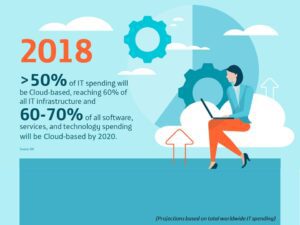Cloud storage is a rather straightforward concept – a service where data is remotely maintained, managed and backed up, allowing users to store their information online with access from ANY location – anywhere in the world – via the Internet (with a private cloud hosting solution residing on an intranet or firewall-protected hosted data center, and a public cloud solution residing in a third-party provider’s data center). Yet despite nearing the time when their in-house servers have either outlived their viability and/or efficiency, some companies nearing their own DSMOT (Data Storage Moment of Truth) have reservations about moving to cloud storage.
The scale of cloud adoption is daunting. Consider these stats from Forrester’s, a market research company, in its recent Predictions 2018:
- The 2018 global public cloud services market is projected to increase +21% from a year ago…with a similar annual rate forecasted for each of the next three years
- Public cloud platforms are the fastest-growing segment
- By 2018, half of all global enterprises will be on public cloud platforms

To further underscore the trend, RightScale, a cloud computing Software as a Service (SaaS) company, recently reported that 38% of enterprises see public cloud as their number-one priority this year (up from 29% a year ago). And CIO.com’s 2018 State of the CIO Survey lists cloud computing as third behind enterprise applications and data/analytics in terms of importance.
WHAT MOTIVATES BUSINESSES TO ADOPT THE CLOUD?
- Improving agility
- Optimizing time-to-market
- Streamlining of processes as an additional way to gain efficiency
- Greater human resource and capacity efficiency
- Increased security controls
- Ability to leverage a subscription-based cost structure and flexibility benefits
These benefits can spur the type that can spur a company to sustained long-term innovation and growth in the all-important race for higher revenues and greater market share.
Moving to the cloud is one of the most-discussed topics in the IT space today. If a company isn’t using the cloud, many develop the business equivalent of FOMO (Fear of Missing Out) and jump in without an understanding of what it is, and what it allows them to do. When asked about cloud strategy, many companies don’t have one. In fact, Gartner, and IT research and advisory firm, estimates that more than two-thirds of organizations don’t have a documented cloud strategy.

A sound cloud strategy begins by:
- Identifying business goals
- Mapping the potential benefits of the cloud
- Mitigating the potential drawbacks of the cloud
Cloud should be thought of as a means to an end, and the end – the goals – must be identified.
Our hope in this blog is to identify the most widely-held myths regarding the cloud – and to use our expertise to shed some light on them, with an objective of helping you decide whether cloud adoption should be part of your business strategy.

MYTH 1: CLOUD = ‘PUBLIC’ = SECURITY RISKS

As ‘cloud’ is often associated with ‘public’ spaces, it has an unfair perception of being less secure. In reality, there have been very few security breaches in the public cloud. According to Gartner, enterprises that implement appropriate cloud visibility and control tools by 2018 will experience ONE-THIRD FEWER security failures than those that do not.
Many businesses have concerns about the safety and privacy of important data stored remotely, and some fear that their data may get mixed up with other cloud users’ data. With breaches on the rise, it’s not surprising that cybersecurity is a key consideration. The security measures on your system can also be established on the cloud, making both equally secure. Here is a quick refresh on cybersecurity:
On-premises and in the cloud, security breaches most commonly occur within these three primary areas:
- Identity and access management
- Misconfigurations
- Software vulnerabilities
To minimize these risks, many companies rely on perimeter-based security controls (like firewalls). These controls play a critical function…but in order to succeed they need to live close to the data and have a strong key management infrastructure. Security must be implemented at ‘ground zero’ – the data access layer – to offer optimal protection as the data moves between systems and clouds. Once security controls exist at this level, then identity and access controls can be considered.
Furthermore, cloud offers security benefits that aren’t available in traditional system infrastructures:
- Increased visibility into your environment
- Improved efficiencies (and protection) through the software-defined nature of provisioning and managing infrastructure
- Patching that’s easier and faster – and typically included with Platform-as-a-Service (PaaS)
- Leveraging the cloud’s massive scale (i.e. the investment resources to deploy unrivaled security technology, as well as the world’s most advanced cybersecurity leaders to maintain and optimize it) to stay multiple steps ahead of compromisers
Due to its adoption (in some form) by a significant majority of the world’s enterprises, a massive cloud scale and broad geographical presence is the cloud’s benefit that you can leverage for your needs, as those assets allow for the ability to detect emerging threats more quickly than just about anywhere else, and address issues before they gain momentum.
Beyond cybersecurity, compliance with global, local, and industry regulation is a significant burden to individual companies. When enterprises employ the services of a cloud provider, they inherit compliance standards and certifications already in place for organizations within its network. Public cloud providers are able to invest massive resources that exceed what any one organization could deploy. TEC can help evaluate your needs and recommend an effective cloud strategy that makes sense for your business.

As Gartner’s 2017 ‘Is The Cloud Secure?’ Report states: “The security posture of major cloud providers is as good as or better than most enterprise data centers, and security should no longer be considered a primary inhibitor to the adoption of public cloud services.” The report projected that the number of breaches experienced by infrastructure-as-a-service systems will be at least 60% lower than those of legacy environments by 2020, and that 95% of cloud security failures by 2020 will be user-related.
MYTH 2: CLOUD = AN ‘ALL OR NOTHING’ COMMITMENT

Adopting the cloud is not an ‘all-or-nothing’ proposition. An increasing number of companies are moving some, but not all, of their information to the cloud – and only a small percentage is moving everything there. Not all workloads are optimal for running in the cloud, so you can still keep what you need on-premises and implement technologies to ensure everything functions seamlessly. This dynamic makes it critical to have either someone on your team or a trusted partner well-versed in cloud logistics, processes and best practices. Considerations when deciding what to migrate to the cloud:
- Identify who accesses your information…and which applications they use
- Look for opportunities to give you and your stakeholders a better and more secure experience
- Identify which apps are good cloud candidates (freeing up internal resources)
- Avoid moving applications that won’t work well in the cloud
Enterprises have diverse needs when it comes to cloud apps, data analytics, development, management, and security. Therefore, meeting these diverse business and productivity needs may require more than one singular cloud solution. Multi-cloud and hybrid-cloud management solutions, an architecture that integrates different cloud platforms to seamlessly route data from one cloud environment to another, have virtually eliminated concerns around vendor lock-in and are instead placing a priority on the IT needs of the business.
MYTH 3: CLOUD = USUALLY COST-PROHIBITIVE

Many companies make the assumption that moving to the cloud will increase their IT costs. There may be some front-end costs incurred when first moving workloads to the cloud or taking advantage of cloud-based services, but the cloud has proven to provide long-term cost savings as it reduces resources that were previously spent on IT maintenance. Those valuable resources can now support and deliver your business objectives.
MYTH 4: CLOUD = MORE COMPLEX THAN IT’S WORTH

Moving to the cloud may seem like a herculean undertaking. But, you don’t need to revolutionize your IT in a single day. Companies of all sizes can realize cloud benefits by simply dipping their toes in the water. Start with moving one application to the cloud (private or public), then more over time as it makes sense. Train engineers. Improve your efficiencies. Learn about your applications and cloud technologies. Find a cloud-experienced partner to optimize your solution and reduce challenges. Enable innovation.
Let the experts build, migrate and manage the cloud; like electrical and plumbing work, IT requires the expertise of certified professionals. Who wants short-circuits and leaky pipelines?
MYTH 5: CLOUD = HAMPERED PERFORMANCE

Two of the biggest benefits of cloud technology are improved availability and reliability from ANYWHERE IN THE WORLD. If everything is configured correctly, you will see improved performance due to efficient resource utilization and fine-tuned services for things like load balancing, cache and database. Many cloud providers also offer flawless integration service with various CDN providers, which can accelerate your dynamic content delivery.
Cloud providers immediately addressed some of cloud’s initial growing pains through improvements and work-specific solutions. They have made their systems resilient to avoid outages, and failures are infrequent compared to other alternatives. The cloud environment can be engineered to adapt to strenuous workloads and high availability requirements that significantly reduces any performance or failure issues.
Today, end-to-end cloud Disaster Recovery automation can eliminate pitfalls and reduce migration time by nearly 75%. The use of VPNs, encryption, and compression provided by automation can also ensure that bandwidth issues are avoided…and live migrations eliminate the need to take applications and workloads offline.
THE FINAL ANALYSIS
While the cost of moving to the cloud is an upfront investment, consider these benefits to your business:
- The multitude of PROPERLY DESIGNED AND CONFIGURED cloud benefits outlined in this blog impact your company’s cybersecurity, flexibility, financial, and identity and access management
- The substantial advancements in cloud technology since its inception (and especially the last several years)
- The ability to leverage the cloud’s massive scale and resultant expertise and resources for your business needs
- The freedom to choose a subscription-based cloud as a service, which enables you to access the same benefits but requires a smaller financial investment
Beyond strictly IT considerations, consider the strategic goals of your business. Are you in it beyond the next several years? Because technology has made it abundantly clear that it’s here to stay. Like most investments with your business, the sooner you make a prudent move towards long-term efficiencies of costs, maintenance, resources, capacity, productivity and time-to-market, the sooner you will realize incremental revenue growth and increased value to your company.
Find out more about how TEC Communications can help your business achieve optimal cloud performance at https://tec4it.com/cloud/


